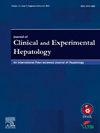Utility of Transient Elastography in Differentiating Biliary Atresia from Other Causes of Neonatal Cholestasis: A Prospective Observational Study
IF 3.3
Q2 GASTROENTEROLOGY & HEPATOLOGY
Journal of Clinical and Experimental Hepatology
Pub Date : 2025-03-08
DOI:10.1016/j.jceh.2025.102543
引用次数: 0
Abstract
Background
Differentiating biliary atresia (BA) from non-BA is paramount, as their management and outcome differ. So far, BA is diagnosed by intraoperative cholangiogram (IOC) or liver biopsy. However, literature is sparse on the utility of transient elastography (TE) in neonatal cholestasis. We aimed to study the usefulness and accuracy of TE in differentiating BA from other causes of neonatal cholestasis (NCS).
Methods
A prospective observational study was conducted from June 2021 to February 2024; consecutive cases of NCS were recruited. Patients were grouped as BA and non-BA. All patients underwent clinical, laboratory, and radiological evaluation, along with TE. Receiver operating characteristic curve (ROC) analysis was performed to derive an LSM cutoff for diagnosing BA. The liver stiffness measurement (LSM) was correlated with histopathological fibrosis.
Results
We enrolled 135 patients, BA (n = 68) and non-BA (n = 67). The median LSM was higher in BA, 19.4 (12.9–38.75) kPa vs. 12.0 (8.4–17.9) kPa (P=<0.001). LSM positively correlated with the METAVIR fibrosis score (Spearman's correlation coefficient, r = 0.590, P < 0.001). We derived an LSM cutoff of 13.1 kPa to differentiate BA from non-BA (sensitivity 75%, specificity 61.2%, AUC 0.736). By adding ultrasound (USG) finding of a small gallbladder (<19 mm) to our LSM cutoff (13.1 kPa), the sensitivity improved to 97.0%, but specificity remained low (52.2%).
Conclusion
LSM correlates well with histopathological fibrosis in NCS. An LSM cut off of 13.1 kPa can be used to differentiate BA from non-BA with a sensitivity of 75%. In resource-constraint setting where liver biopsy and IOC may not be available, TE in combination with USG can be a good screening tool for BA (sensitivity 97%).

瞬时弹性成像在鉴别胆道闭锁与其他原因的新生儿胆汁淤积中的应用:一项前瞻性观察研究
背景鉴别胆道闭锁(BA)和非胆道闭锁至关重要,因为它们的治疗方法和结果各不相同。迄今为止,胆道闭锁都是通过术中胆管造影(IOC)或肝活检来诊断的。然而,关于瞬态弹性成像(TE)在新生儿胆汁淤积症中的实用性的文献却很少。我们的目的是研究瞬态弹性成像在区分胆汁淤积症和其他原因引起的新生儿胆汁淤积症(NCS)方面的实用性和准确性。患者分为胆汁淤积症和非胆汁淤积症两组。所有患者均接受了临床、实验室和放射学评估以及 TE。通过接收操作特征曲线(ROC)分析,得出了诊断 BA 的 LSM 临界值。肝脏硬度测量(LSM)与组织病理学纤维化相关。BA 患者的 LSM 中位数较高,为 19.4 (12.9-38.75) kPa vs. 12.0 (8.4-17.9) kPa (P=<0.001)。LSM 与 METAVIR 纤维化评分呈正相关(斯皮尔曼相关系数,r = 0.590,P = 0.001)。我们将 LSM 临界值定为 13.1 kPa,以区分 BA 和非 BA(灵敏度 75%,特异度 61.2%,AUC 0.736)。通过在 LSM 临界值(13.1 kPa)中加入超声(USG)发现的小胆囊(<19 mm),灵敏度提高到 97.0%,但特异性仍然很低(52.2%)。13.1 kPa 的 LSM 临界值可用于区分 BA 和非 BA,灵敏度为 75%。在资源有限、无法进行肝活检和 IOC 的情况下,TE 与 USG 联用可作为 BA 的良好筛查工具(灵敏度为 97%)。
本文章由计算机程序翻译,如有差异,请以英文原文为准。
求助全文
约1分钟内获得全文
求助全文
来源期刊

Journal of Clinical and Experimental Hepatology
GASTROENTEROLOGY & HEPATOLOGY-
CiteScore
4.90
自引率
16.70%
发文量
537
审稿时长
64 days
 求助内容:
求助内容: 应助结果提醒方式:
应助结果提醒方式:


